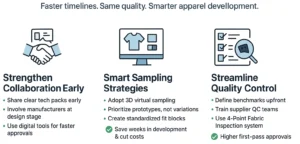By Antor Hossain
Email: antor@anto.xyz | Website: https://antor.xyz
As the fashion industry has become increasingly globalized, the role of the technical designer has grown in importance. This role emerged when many fashion brands began outsourcing production to offshore manufacturers, creating a need for a specialist to manage the technical details of product development. The technical designer ensures that everything from the measurements to the construction methods of garments is executed perfectly by manufacturers, no matter where they are located.

What Is Technical Design?
Technical design, often referred to as tech design, is the process of developing the detailed specifications, drawings, and patterns needed to turn a designer’s creative vision into a finished product. Technical designers work closely with production teams to ensure garments are made according to precise measurements and construction guidelines. Their work covers everything from fabric choices and trim colors to ensuring that garments are made to the correct size and fit.
The goal of technical design is to provide manufacturers with all the information they need to produce garments that meet the designer’s standards for fit, construction, and quality. Technical designers also play a critical role in ensuring the efficiency of the production process by reducing errors and preventing costly delays.
Why Technical Designers Are Essential
Technical designers are vital to the fashion industry because they ensure that the creative vision of the designer translates into a high-quality, well-constructed garment that can be produced efficiently. As production has moved offshore, the need for precise and accurate specifications has increased. Without technical designers, it would be nearly impossible to maintain the consistency and quality of garments across different manufacturers and production facilities.
Their work impacts several key areas:
- Fit and Quality: They ensure that garments fit properly and meet the brand’s quality standards.
- Manufacturing Efficiency: By providing clear and detailed instructions, technical designers help reduce errors during production, saving time and resources.
- Cost Management: Technical design contributes to cost-effectiveness by minimizing the need for corrections or remakes during production.
The Role of the Technical Designer
A technical designer acts as the bridge between the designer’s creative ideas and the practical realities of garment production. They are responsible for ensuring that the designer’s vision is translated into clear, actionable instructions for manufacturers. The primary focus of the technical designer is on the fit, construction, and quality of garments rather than the design itself.
Key Responsibilities
While the exact duties of a technical designer can vary depending on the company, their general responsibilities typically include:
- Managing the Fit Process: From the first sample fitting through to final production, the technical designer oversees garment fit to ensure consistency and quality.
- Product Specifications: Creating and managing detailed product specifications, including measurements, construction details, and fabric/trim information.
- Conducting Fittings: Working with live models or dress forms to ensure garments fit as intended and making necessary adjustments.
- Resolving Construction Issues: Troubleshooting any problems related to garment construction or manufacturing to ensure the final product meets brand standards.
- Overseeing Production Samples: Tracking and reviewing samples at various stages of production to ensure adherence to specifications.
- Collaboration: Communicating with overseas manufacturers, often across different time zones, to ensure that production is on track and any issues are resolved promptly.
Technical designers also play a role in ensuring that garments meet regulatory requirements, such as care-labeling instructions, and may be involved in conducting stock reviews to assess the quality of finished goods.
Skills and Qualifications of a Technical Designer
To become a technical designer, a combination of technical skills, education, and hands-on experience is required. Below are the key qualifications and skills that successful technical designers possess:
Education
A minimum of an associate’s degree in fashion design, product development, or a related field is typically required. Most technical designers, however, have a bachelor’s degree, and many also have specialized training in patternmaking or computer-aided design (CAD).
Technical Skills
- Patternmaking and Draping: A deep understanding of how garments are constructed and how patterns are created is crucial.
- CAD Software: Proficiency in software like Adobe Illustrator, Photoshop, Kaledo, and other industry-specific tools for creating and editing designs.
- Attention to Detail: Technical designers must be meticulous in ensuring that all specifications are accurate and clearly communicated to manufacturers.
Experience
Many technical designers begin their careers as specification technicians, working closely with senior technical designers or product developers to learn the ropes. Internships with fashion brands or manufacturers can also provide valuable hands-on experience. Building a strong portfolio of work is essential, as this is often the best way to showcase technical expertise to potential employers.
Interpersonal Skills
A successful technical designer must possess strong communication and interpersonal skills, as they often act as a liaison between designers and manufacturers. The ability to collaborate with cross-disciplinary teams, troubleshoot problems, and manage tight deadlines is essential.
Challenges in Technical Design Careers
While a career in technical design can be rewarding, it is not without its challenges. The fast-paced nature of the fashion industry often requires technical designers to work under tight deadlines, especially as production schedules can be affected by delays or changes in design requirements. Overtime is common during busy periods, and some technical designers may be required to travel internationally to meet with manufacturers.
Despite these challenges, the demand for skilled technical designers continues to grow, especially as more brands outsource their production overseas. With the right combination of technical expertise, creativity, and communication skills, a career in technical design offers plenty of opportunities for advancement in the fashion industry.
Conclusion
In today’s fashion industry, the technical designer plays a critical role in ensuring that a brand’s garments are produced to the highest standards of quality and fit. By bridging the gap between designers and manufacturers, technical designers help ensure that the creative vision of a brand is fully realized, from the initial sketch to the final product. As the industry continues to evolve, the role of the technical designer will remain central to the success of fashion brands around the world.






